Porous Fly Ash/Aluminosilicate Microspheres-Based Composites Containing Lightweight Granules Using Liquid Glass as Binder
Abstract
1. Introduction
- -
- Substantiation of the composition and processing parameters of the molding sand to obtain porous liquid glass granules and the study of the properties of the granulated material;
- -
- Study of the effect of curing temperature on the properties of the liquid glass binder;
- -
- Development of the composition and study of the properties of a composite material with a density of not more than 650 kg/m3 based on porous granules and a matrix of liquid glass mixtures;
- -
- Development of the fundamentals of technology for the production of granular and composite materials.
2. Materials and Methods
2.1. Materials
2.2. Mix Design
2.3. Methods
2.3.1. Preparation of Raw Materials
2.3.2. Molding and Research of Properties of Granules
2.3.3. Preparation and Study of Liquid Glass Binder
2.3.4. Preparation of Molding Mixes and Production of Samples of Composite Materials
2.3.5. The Tests
3. Results and Discussion
3.1. Influence of Technological Factors on the Formation and Properties of Liquid Glass Granules
3.2. Study of the Binder for Composite Materials
3.3. Research of Liquid Glass Composite Materials
3.4. Fundamentals of the Technology of Liquid Glass Composite Material
4. Conclusions
Author Contributions
Funding
Institutional Review Board Statement
Informed Consent Statement
Data Availability Statement
Conflicts of Interest
References
- Bessmertnyi, V.S.; Lesovik, V.S.; Krokhin, V.P. The Reducing Effect of Argon in the Plasma Treatment of High-Melting Nonmetallic Materials (a Review). Glas. Ceram. 2001, 58, 362–364. [Google Scholar] [CrossRef]
- Pavlikova, M.; Zemanova, L.; Zaleska, M.; Pokorny, J.; Lojka, M.; Jankovsky, O.; Pavlik, Z. Ternary Blended Binder for Production of a Novel Type of Lightweight Repair Mortar. Materials 2019, 12, 996. [Google Scholar] [CrossRef] [PubMed]
- Lu, J.-X.; Shen, P.; Ali, H.A.; Poon, C.S. Mix Design and Performance of Lightweight Ultra High-Performance Concrete. Mater. Des. 2022, 216, 110553. [Google Scholar] [CrossRef]
- Lu, J.-X.; Shen, P.; Ali, H.A.; Poon, C.S. Development of High Performance Lightweight Concrete Using Ultra High Performance Cementitious Composite and Different Lightweight Aggregates. Cem. Concr. Compos. 2021, 124, 104277. [Google Scholar] [CrossRef]
- Lee, Y.H.; Chua, N.; Amran, M.; Yong Lee, Y.; Hong Kueh, A.B.; Fediuk, R.; Vatin, N.; Vasilev, Y. Thermal Performance of Structural Lightweight Concrete Composites for Potential Energy Saving. Crystals 2021, 11, 461. [Google Scholar] [CrossRef]
- Mo, K.H.; Hussin, M.N.; Ling, T.-C.; Ramli Sulong, N.H.; Lee, F.W.; Yuen, C.W. Development of Lightweight Aggregate Mortar Skin Layer for an Innovative Sandwich Concrete Composite. J. Build. Eng. 2020, 27, 100941. [Google Scholar] [CrossRef]
- Makul, N.; Fediuk, R.; Amran, M.; Zeyad, A.M.; Murali, G.; Vatin, N.; Klyuev, S.; Ozbakkaloglu, T.; Vasilev, Y. Use of Recycled Concrete Aggregates in Production of Green Cement-Based Concrete Composites: A Review. Crystals 2021, 11, 232. [Google Scholar] [CrossRef]
- Bai, G.; Wang, L.; Ma, G.; Sanjayan, J.; Bai, M. 3D Printing Eco-Friendly Concrete Containing under-Utilised and Waste Solids as Aggregates. Cem. Concr. Compos. 2021, 120, 104037. [Google Scholar] [CrossRef]
- Kellenberger, D.; Althaus, H.-J.; Jungbluth, N.; Künninger, T.; Lehmann, M.; Thalmann, P. Life Cycle Inventories of Building Products; Swiss Cemtre for Life Circle Inventories: Dubendorf, Switzerland, 2007. [Google Scholar]
- Wang, F.; Zheng, W.; Qiao, Z.; Qi, Y.; Chen, Z.; Li, H. Study of the Structural-Functional Lightweight Concrete Containing Novel Hollow Ceramsite Compounded with Paraffin. Constr. Build. Mater. 2022, 342, 127954. [Google Scholar] [CrossRef]
- Li, M.; Zhou, D.; Jiang, Y. Preparation and Thermal Storage Performance of Phase Change Ceramsite Sand and Thermal Storage Light-Weight Concrete. Renew. Energy 2021, 175, 143–152. [Google Scholar] [CrossRef]
- Lu, Y.; Hu, X.; Yang, X.; Xiao, Y. Comprehensive Tests and Quasi-Brittle Fracture Modeling of Light-Weight Foam Concrete with Expanded Clay Aggregates. Cem. Concr. Compos. 2021, 115, 103822. [Google Scholar] [CrossRef]
- Fediuk, R. Reducing Permeability of Fiber Concrete Using Composite Binders. Spec. Top. Rev. Porous Media An. Int. J. 2018, 9, 79–89. [Google Scholar] [CrossRef]
- Tie, T.S.; Mo, K.H.; Putra, A.; Loo, S.C.; Alengaram, U.J.; Ling, T.C. Sound Absorption Performance of Modified Concrete: A Review. J. Build. Eng. 2020, 30, 101219. [Google Scholar] [CrossRef]
- Abid, S.R.; Murali, G.; Amran, M.; Vatin, N.; Fediuk, R.; Karelina, M. Evaluation of Mode II Fracture Toughness of Hybrid Fibrous Geopolymer Composites. Materials 2021, 14, 349. [Google Scholar] [CrossRef] [PubMed]
- Singh, M.; Siddique, R. Effect of Coal Bottom Ash as Partial Replacement of Sand on Properties of Concrete. Resour. Conserv. Recycl. 2013, 72, 20–32. [Google Scholar] [CrossRef]
- Zaetang, Y.; Wongsa, A.; Sata, V.; Chindaprasirt, P. Use of Lightweight Aggregates in Pervious Concrete. Constr. Build. Mater. 2013, 48, 585–591. [Google Scholar] [CrossRef]
- Loutou, M.; Hajjaji, M. Clayey Wastes-Based Lightweight Aggregates: Heating Transformations and Physical/Mechanical Properties. Appl. Clay Sci. 2017, 150, 56–62. [Google Scholar] [CrossRef]
- Golias, M.; Castro, J.; Weiss, J. The Influence of the Initial Moisture Content of Lightweight Aggregate on Internal Curing. Constr. Build. Mater. 2012, 35, 52–62. [Google Scholar] [CrossRef]
- Hasan, M.; Saidi, T.; Afifuddin, M. Mechanical Properties and Absorption of Lightweight Concrete Using Lightweight Aggregate from Diatomaceous Earth. Constr. Build. Mater. 2021, 277, 122324. [Google Scholar] [CrossRef]
- Yaghoubi, E.; Disfani, M.M.; Arulrajah, A.; Al-Taie, A. A Prediction Model for the Loading-Wetting Volumetric Behavior of Unsaturated Granular Materials. Soils Found. 2021, 61, 623–641. [Google Scholar] [CrossRef]
- De Azevedo, A.R.G.; Cruz, A.S.A.; Marvila, M.T.; de Oliveira, L.B.; Monteiro, S.N.; Vieira, C.M.F.; Fediuk, R.; Timokhin, R.; Vatin, N.; Daironas, M. Natural Fibers as an Alternative to Synthetic Fibers in Reinforcement of Geopolymer Matrices: A Comparative Review. Polymers 2021, 13, 2493. [Google Scholar] [CrossRef] [PubMed]
- Chinnu, S.N.; Minnu, S.N.; Bahurudeen, A.; Senthilkumar, R. Reuse of Industrial and Agricultural By-Products as Pozzolan and Aggregates in Lightweight Concrete. Constr. Build. Mater. 2021, 302, 124172. [Google Scholar] [CrossRef]
- Muthusamy, K.; Zamri, N.A. Mechanical Properties of Oil Palm Shell Lightweight Aggregate Concrete Containing Palm Oil Fuel Ash as Partial Cement Replacement. KSCE J. Civ. Eng. 2016, 20, 1473–1481. [Google Scholar] [CrossRef]
- Wu, Y.; Liu, C.; Liu, H.; Hu, H.; He, C.; Song, L.; Huang, W. Pore Structure and Durability of Green Concrete Containing Recycled Powder and Recycled Coarse Aggregate. J. Build. Eng. 2022, 53, 104584. [Google Scholar] [CrossRef]
- Senthamarai, R.; Manoharan, P.D.; Gobinath, D. Concrete Made from Ceramic Industry Waste: Durability Properties. Constr. Build. Mater. 2011, 25, 2413–2419. [Google Scholar] [CrossRef]
- Yaphary, Y.L.; Lu, J.-X.; Chengbin, X.; Shen, P.; Ali, H.A.; Xuan, D.; Poon, C.S. Characteristics and Production of Semi-Dry Lightweight Concrete with Cold Bonded Aggregates Made from Recycling Concrete Slurry Waste (CSW) and Municipal Solid Waste Incineration Bottom Ash (MSWIBA). J. Build. Eng. 2022, 45, 103434. [Google Scholar] [CrossRef]
- Bajukov, O.A.; Anshits, N.N.; Petrov, M.I.; Balaev, A.D.; Anshits, A.G. Composition of Ferrospinel Phase and Magnetic Properties of Microspheres and Cenospheres from Fly Ashes. Mater. Chem. Phys. 2009, 114, 495–503. [Google Scholar] [CrossRef]
- Cerny, V.; Kocianova, M.; Drochytka, R. Possibilities of Lightweight High Strength Concrete Production from Sintered Fly Ash Aggregate. Procedia Eng. 2017, 195, 9–16. [Google Scholar] [CrossRef]
- Nadesan, M.S.; Dinakar, P. Influence of Type of Binder on High-Performance Sintered Fly Ash Lightweight Aggregate Concrete. Constr. Build. Mater. 2018, 176, 665–675. [Google Scholar] [CrossRef]
- Balapour, M.; Khaneghahi, M.H.; Garboczi, E.J.; Hsuan, Y.G.; Hun, D.E.; Farnam, Y. Off-Spec Fly Ash-Based Lightweight Aggregate Properties and Their Influence on the Fresh, Mechanical, and Hydration Properties of Lightweight Concrete: A Comparative Study. Constr. Build. Mater. 2022, 342, 128013. [Google Scholar] [CrossRef]
- Bouzoubaâ, N.; Lachemi, M. Self-Compacting Concrete Incorporating High Volumes of Class F Fly Ash. Cem. Concr. Res. 2001, 31, 413–420. [Google Scholar] [CrossRef]
- Adhikary, S.K.; Rudžionis, Ž.; Tučkutė, S. Characterization of Novel Lightweight Self-Compacting Cement Composites with Incorporated Expanded Glass, Aerogel, Zeolite and Fly Ash. Case Stud. Constr. Mater. 2022, 16, e00879. [Google Scholar] [CrossRef]
- Usanova, K.; Barabanshchikov, Y.G. Cold-Bonded Fly Ash Aggregate Concrete. Mag. Civ. Eng. 2020, 95, 104–118. [Google Scholar] [CrossRef]
- Narattha, C.; Chaipanich, A. Phase Characterizations, Physical Properties and Strength of Environment-Friendly Cold-Bonded Fly Ash Lightweight Aggregates. J. Clean. Prod. 2018, 171, 1094–1100. [Google Scholar] [CrossRef]
- Zhu, L.; Dang, F.; Xue, Y.; Jiao, K.; Ding, W. Multivariate Analysis of Effects of Microencapsulated Phase Change Materials on Mechanical Behaviors in Light-Weight Aggregate Concrete. J. Build. Eng. 2021, 42, 102783. [Google Scholar] [CrossRef]
- Majhi, R.K.; Padhy, A.; Nayak, A.N. Performance of Structural Lightweight Concrete Produced by Utilizing High Volume of Fly Ash Cenosphere and Sintered Fly Ash Aggregate with Silica Fume. Clean. Eng. Technol. 2021, 3, 100121. [Google Scholar] [CrossRef]
- Li, X.; He, C.; Lv, Y.; Jian, S.; Liu, G.; Jiang, W.; Jiang, D. Utilization of Municipal Sewage Sludge and Waste Glass Powder in Production of Lightweight Aggregates. Constr. Build. Mater. 2020, 256, 119413. [Google Scholar] [CrossRef]
- Rashad, A.M. Recycled Waste Glass as FIne Aggregate Replacement in Cementitious Materials Based on Portland Cement. Constr. Build. Mater. 2014, 72, 340–357. [Google Scholar] [CrossRef]
- Graziano, S.F.; Zanelli, C.; Molinari, C.; de Gennaro, B.; Giovinco, G.; Correggia, C.; Cappelletti, P.; Dondi, M. Use of Screen Glass and Polishing Sludge in Waste-Based Expanded Aggregates for Resource-Saving Lightweight Concrete. J. Clean. Prod. 2022, 332, 130089. [Google Scholar] [CrossRef]
- Schumacher, K.; Saßmannshausen, N.; Pritzel, C.; Trettin, R. Lightweight Aggregate Concrete with an Open Structure and a Porous Matrix with an Improved Ratio of Compressive Strength to Dry Density. Constr. Build. Mater. 2020, 264, 120167. [Google Scholar] [CrossRef]
- Vaganov, V.; Popov, M.; Korjakins, A.; Šahmenko, G. Effect of CNT on Microstructure and Minearological Composition of Lightweight Concrete with Granulated Foam Glass. Procedia Eng. 2017, 172, 1204–1211. [Google Scholar] [CrossRef]
- Kurtulus, C.; Kurtulus, R.; Kavas, T. Foam Glass Derived from Ferrochrome Slag and Waste Container Glass: Synthesis and Extensive Characterizations. Ceram. Int. 2021, 47, 24997–25008. [Google Scholar] [CrossRef]
- Miryuk, O.; Fediuk, R.; Amran, M. Foam Glass Crystalline Granular Material from a Polymineral Raw Mix. Crystals 2021, 11, 1447. [Google Scholar] [CrossRef]
- Mizuryaev, S.A. Some Aspects of the Development and Application of Silicate Expanded Aggregates in Lightweight Concrete Structures. Procedia Eng. 2016, 153, 599–603. [Google Scholar] [CrossRef][Green Version]
- Miryuk, O. Porous Materials Based on Liquid Glass. MOJ Appl. Bionics Biomech. 2018, 2, 170–172. [Google Scholar] [CrossRef]
- Miryuk, O. Liquid-Glass Concrete of Variable Density. IOP Conf. Ser. Mater. Sci. Eng. 2020, 869, 032025. [Google Scholar] [CrossRef]
- Koksal, F.; Sahin, Y.; Gencel, O. Influence of Expanded Vermiculite Powder and Silica Fume on Properties of Foam Concretes. Constr. Build. Mater. 2020, 257, 119547. [Google Scholar] [CrossRef]
- Wang, X.; Chen, S.; Yang, Z.; Ren, J.; Zhang, X.; Xing, F. Self-Healing Concrete Incorporating Mineral Additives and Encapsulated Lightweight Aggregates: Preparation and Application. Constr. Build. Mater. 2021, 301, 124119. [Google Scholar] [CrossRef]
- Miryuk, O.A. Alkaline Silicate Compositions of Porous Structure. ARPN J. Eng. Appl. Sci. 2022, 17, 509–517. [Google Scholar]
- Duan, W.; Zhuge, Y.; Pham, P.N.; Liu, Y.; Kitipornchai, S. A Ternary Blended Binder Incorporating Alum Sludge to Efficiently Resist Alkali-Silica Reaction of Recycled Glass Aggregates. J. Clean. Prod. 2022, 349, 131415. [Google Scholar] [CrossRef]
- Wang, Y.; Mo, K.H.; Du, H.; Ling, T.-C. Effects of CO2 Curing Treatment on Alkali-Silica Reaction of Mortars Containing Glass Aggregate. Constr. Build. Mater. 2022, 323, 126637. [Google Scholar] [CrossRef]
- Matos, A.M.; Silva, F.A.N.; Azevedo, A.C.; Marins, J.F.; Delgado, J.M.P.Q. Alkali-Reactivity of Pernambuco East Shear Zone Coarse Concrete Aggregates: An Experimental Discussion. Constr. Build. Mater. 2022, 344, 128239. [Google Scholar] [CrossRef]
- Zheng, X.; Liu, H.; You, S.; Easa, S.; Cheng, K.; Chen, Z.; Ji, T. Cracking Resistance and Sustainability Assessment of Alkali-Activated Slag Concrete Incorporating Lightweight Aggregate. Cem. Concr. Compos. 2022, 131, 104556. [Google Scholar] [CrossRef]
- Gonçalves, M.; Novais, R.M.; Senff, L.; Carvalheiras, J.; Labrincha, J.A. PCM-Containing Bi-Layered Alkali-Activated Materials: A Novel and Sustainable Route to Regulate the Temperature and Humidity Fluctuations inside Buildings. Build. Environ. 2021, 205, 108281. [Google Scholar] [CrossRef]
- Palacios, M.; Gismera, S.; Alonso, M.M.; d’Espinose de Lacaillerie, J.B.; Lothenbach, B.; Favier, A.; Brumaud, C.; Puertas, F. Early Reactivity of Sodium Silicate-Activated Slag Pastes and Its Impact on Rheological Properties. Cem. Concr. Res. 2021, 140, 106302. [Google Scholar] [CrossRef]
- Dadsetan, S.; Siad, H.; Lachemi, M.; Mahmoodi, O.; Sahmaran, M. Optimization and Characterization of Geopolymer Binders from Ceramic Waste, Glass Waste and Sodium Glass Liquid. J. Clean. Prod. 2022, 342, 130931. [Google Scholar] [CrossRef]
- Yang, T.; Zhu, H.; Zhang, Z.; Gao, X.; Zhang, C.; Wu, Q. Effect of Fly Ash Microsphere on the Rheology and Microstructure of Alkali-Activated Fly Ash/Slag Pastes. Cem. Concr. Res. 2018, 109, 198–207. [Google Scholar] [CrossRef]
- Ismail, I.; Bernal, S.A.; Provis, J.L.; San Nicolas, R.; Hamdan, S.; van Deventer, J.S.J. Modification of Phase Evolution in Alkali-Activated Blast Furnace Slag by the Incorporation of Fly Ash. Cem. Concr. Compos. 2014, 45, 125–135. [Google Scholar] [CrossRef]
- Gao, X.; Yu, Q.L.; Brouwers, H.J.H. Assessing the Porosity and Shrinkage of Alkali Activated Slag-Fly Ash Composites Designed Applying a Packing Model. Constr. Build. Mater. 2016, 119, 175–184. [Google Scholar] [CrossRef]
- Zhang, Z.; Li, L.; Ma, X.; Wang, H. Compositional, Microstructural and Mechanical Properties of Ambient Condition Cured Alkali-Activated Cement. Constr. Build. Mater. 2016, 113, 237–245. [Google Scholar] [CrossRef]
- Gao, X.; Yu, Q.L.; Brouwers, H.J.H. Reaction Kinetics, Gel Character and Strength of Ambient Temperature Cured Alkali Activated Slag–Fly Ash Blends. Constr. Build. Mater. 2015, 80, 105–115. [Google Scholar] [CrossRef]
- Park, S.M.; Jang, J.G.; Lee, N.K.; Lee, H.K. Physicochemical Properties of Binder Gel in Alkali-Activated Fly Ash/Slag Exposed to High Temperatures. Cem. Concr. Res. 2016, 89, 72–79. [Google Scholar] [CrossRef]
- Lotov, A.V.; Kutugin, V.A. Formation of the Porous Structure in Foam Silicates Based on Liquid Glass Compositions. Glass Ceram. 2008, 65, 6–10. [Google Scholar] [CrossRef]
- Vereshchagin, V.I.; Borilo, L.P.; Kozik, A.V. Porous Composition Materials on the Base of Liquid Glass and Natural Silicates. Glas. Ceram. 2002, 75, 26–28. [Google Scholar]
- Huang, Z.; Zhou, Y.; Cui, Y. Effect of Different NaOH Solution Concentrations on Mechanical Properties and Microstructure of Alkali-Activated Blast Furnace Ferronickel Slag. Crystals 2021, 11, 1301. [Google Scholar] [CrossRef]
- Siddika, A.; Hajimohammadi, A.; Sahajwalla, V. Stabilisation of Pores in Glass Foam by Using a Modified Curing-Sintering Process: Sustainable Recycling of Automotive Vehicles’ Waste Glass. Resour. Conserv. Recycl. 2022, 179, 106145. [Google Scholar] [CrossRef]
- Limbachiya, M.; Meddah, M.S.; Fotiadou, S. Performance of Granulated Foam Glass Concrete. Constr. Build. Mater. 2012, 28, 759–768. [Google Scholar] [CrossRef]
- Alnahhal, A.M.; Alengaram, U.J.; Yusoff, S.; Darvish, P.; Srinivas, K.; Sumesh, M. Engineering Performance of Sustainable Geopolymer Foamed and Non-Foamed Concretes. Constr. Build. Mater. 2022, 316, 125601. [Google Scholar] [CrossRef]
- Nodehi, M.; Ozbakkaloglu, T.; Gholampour, A.; Mohammed, T.; Shi, X. The Effect of Curing Regimes on Physico-Mechanical, Microstructural and Durability Properties of Alkali-Activated Materials: A Review. Constr. Build. Mater. 2022, 321, 126335. [Google Scholar] [CrossRef]
- Al-Absi, Z.A.; Hafizal, M.I.M.; Ismail, M. Experimental Study on the Thermal Performance of PCM-Based Panels Developed for Exterior Finishes of Building Walls. J. Build. Eng. 2022, 52, 104379. [Google Scholar] [CrossRef]
- Al-Absi, Z.A.; Hafizal, M.I.M.; Ismail, M.; Awang, H.; Al-Shwaiter, A. Properties of PCM-Based Composites Developed for the Exterior Finishes of Building Walls. Case Stud. Constr. Mater. 2022, 16, e00960. [Google Scholar] [CrossRef]
- Rong, L.; Yuewu, H. Heat and Moisture Transfer Characteristics of Multilayer Walls. Energy Procedia 2018, 152, 324–329. [Google Scholar] [CrossRef]
- Tusnina, V.; Tusnin, A.; Alekperov, R. Experimental and Theoretical Studies of the Thermal Efficiency of Multilayer Non-Uniform Building Enclosures. J. Build. Eng. 2022, 45, 103439. [Google Scholar] [CrossRef]

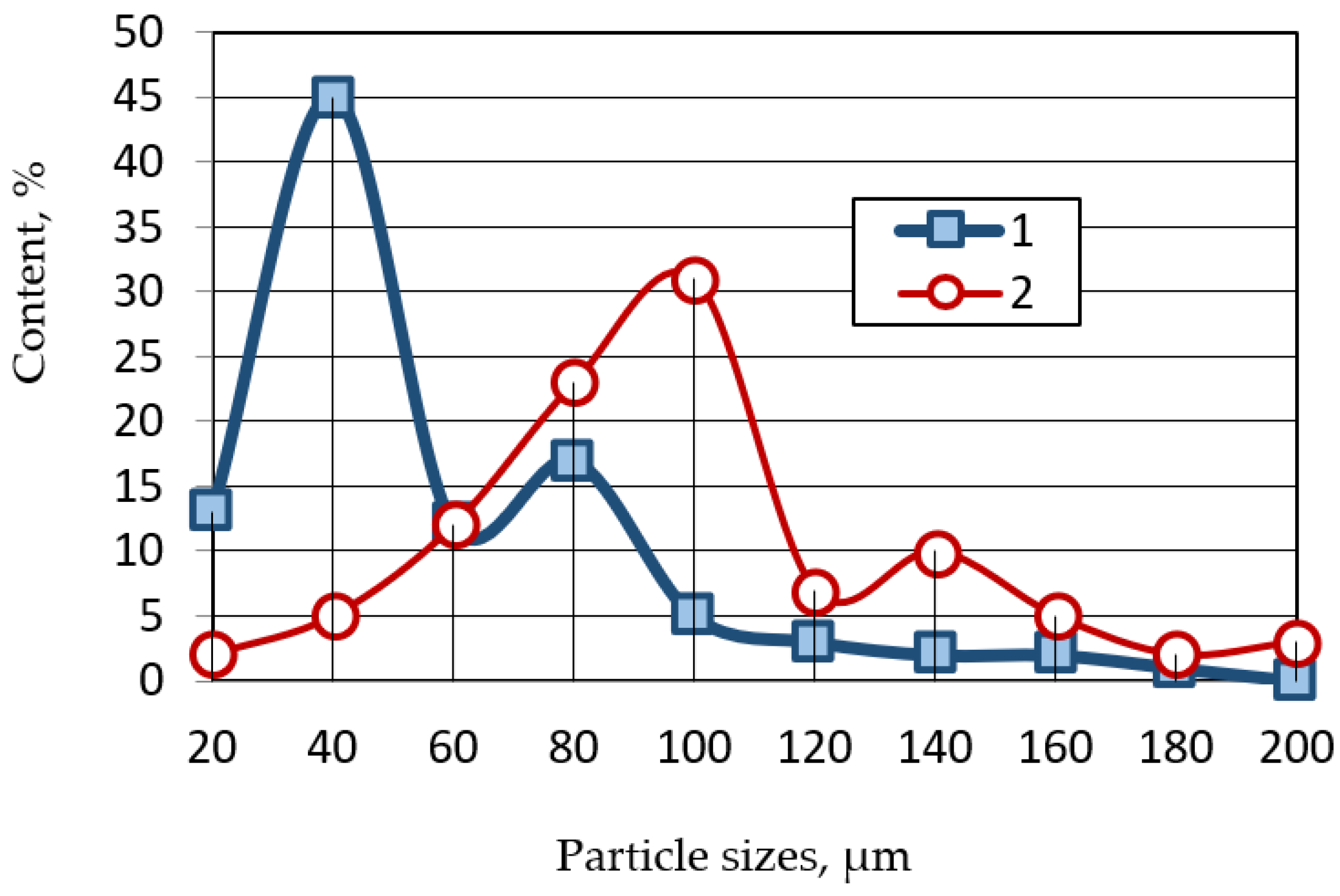
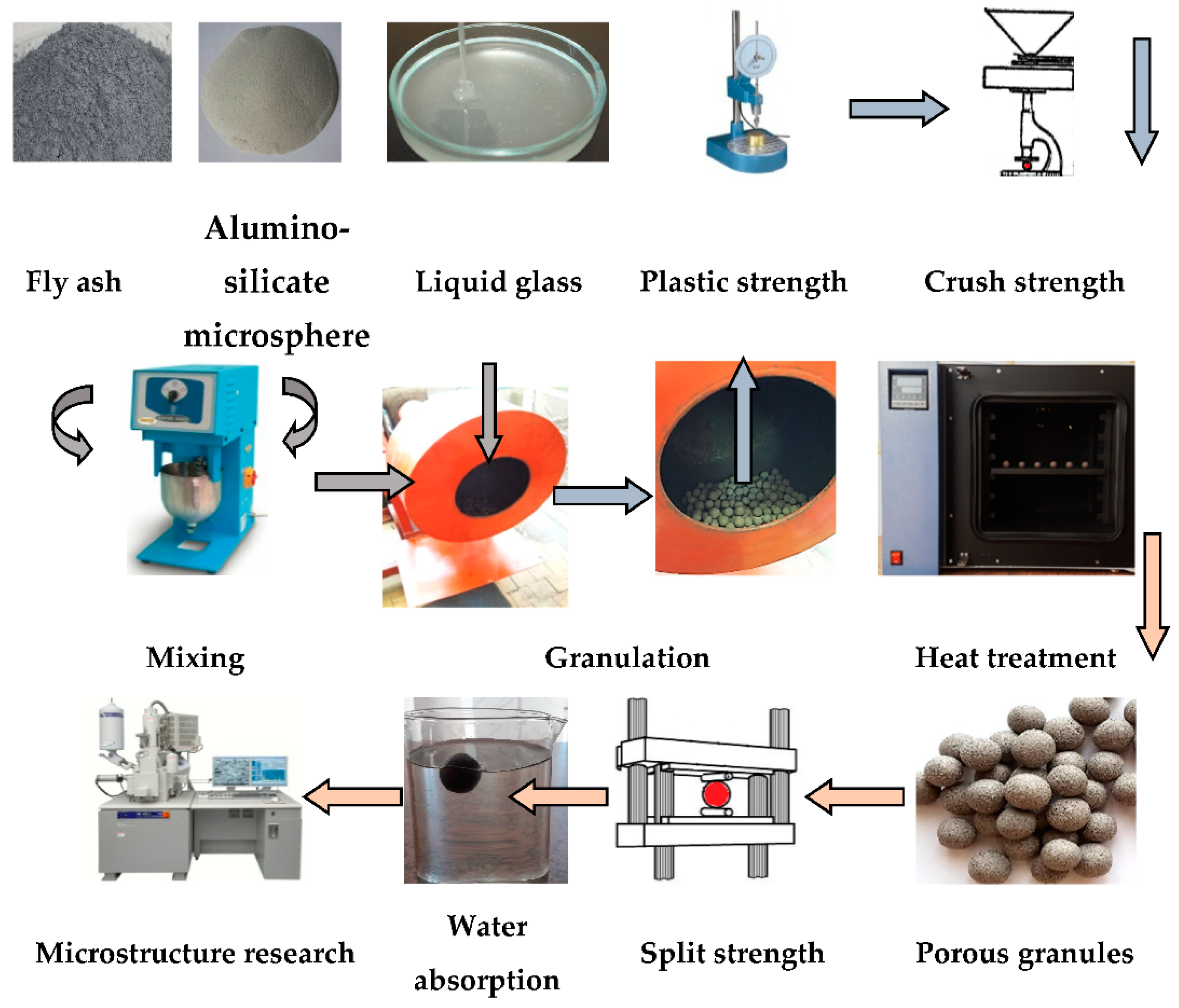
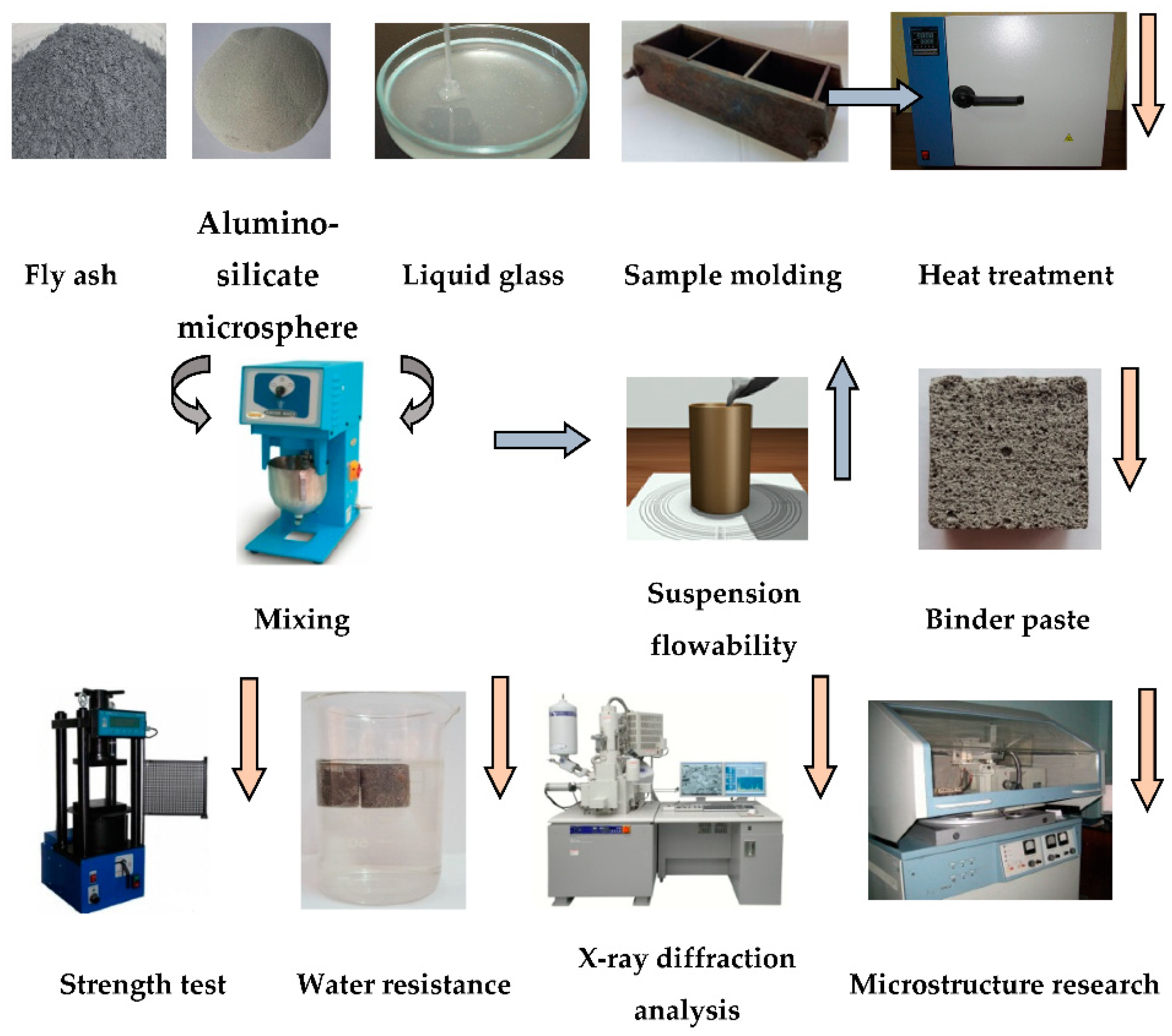

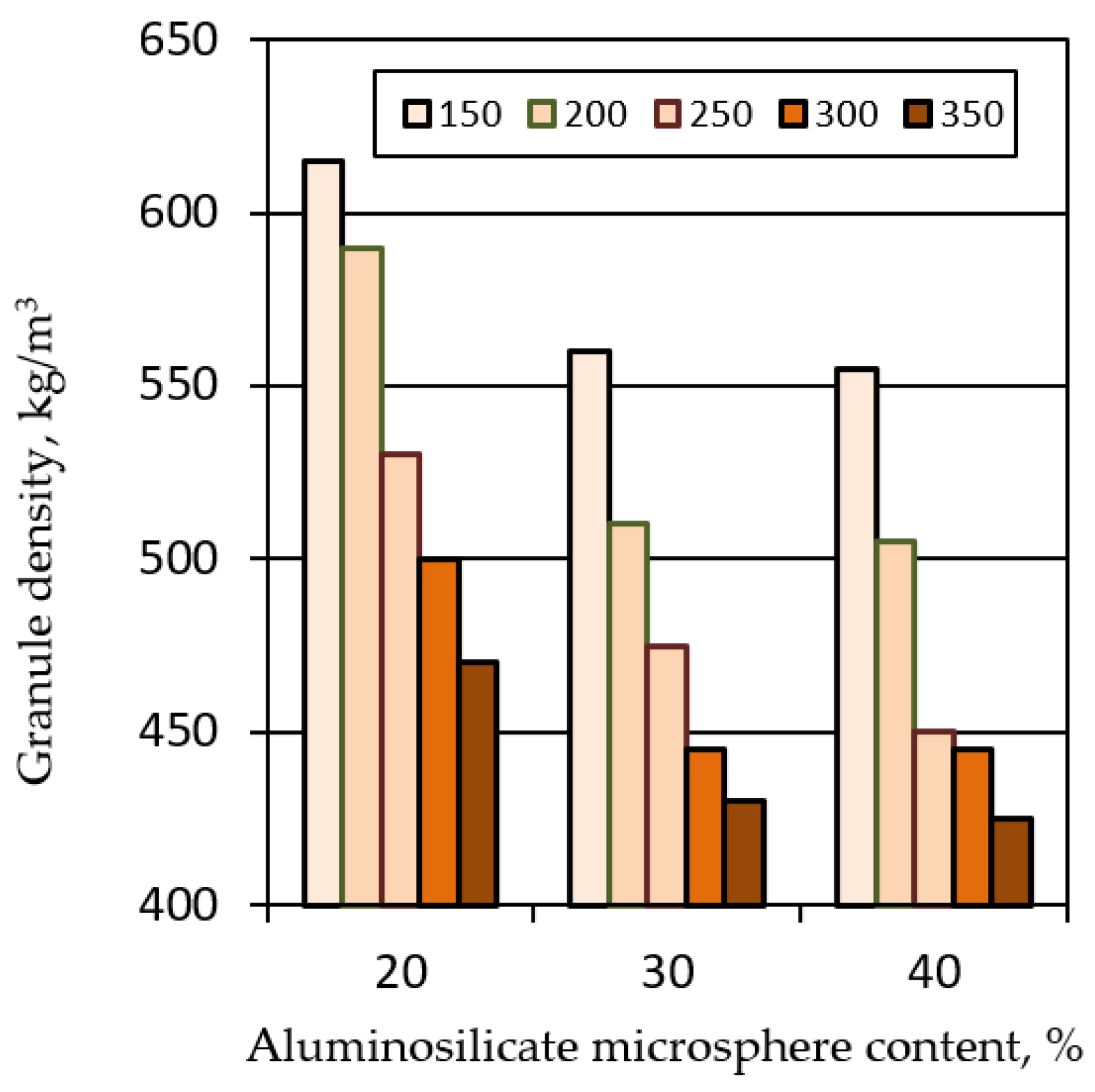
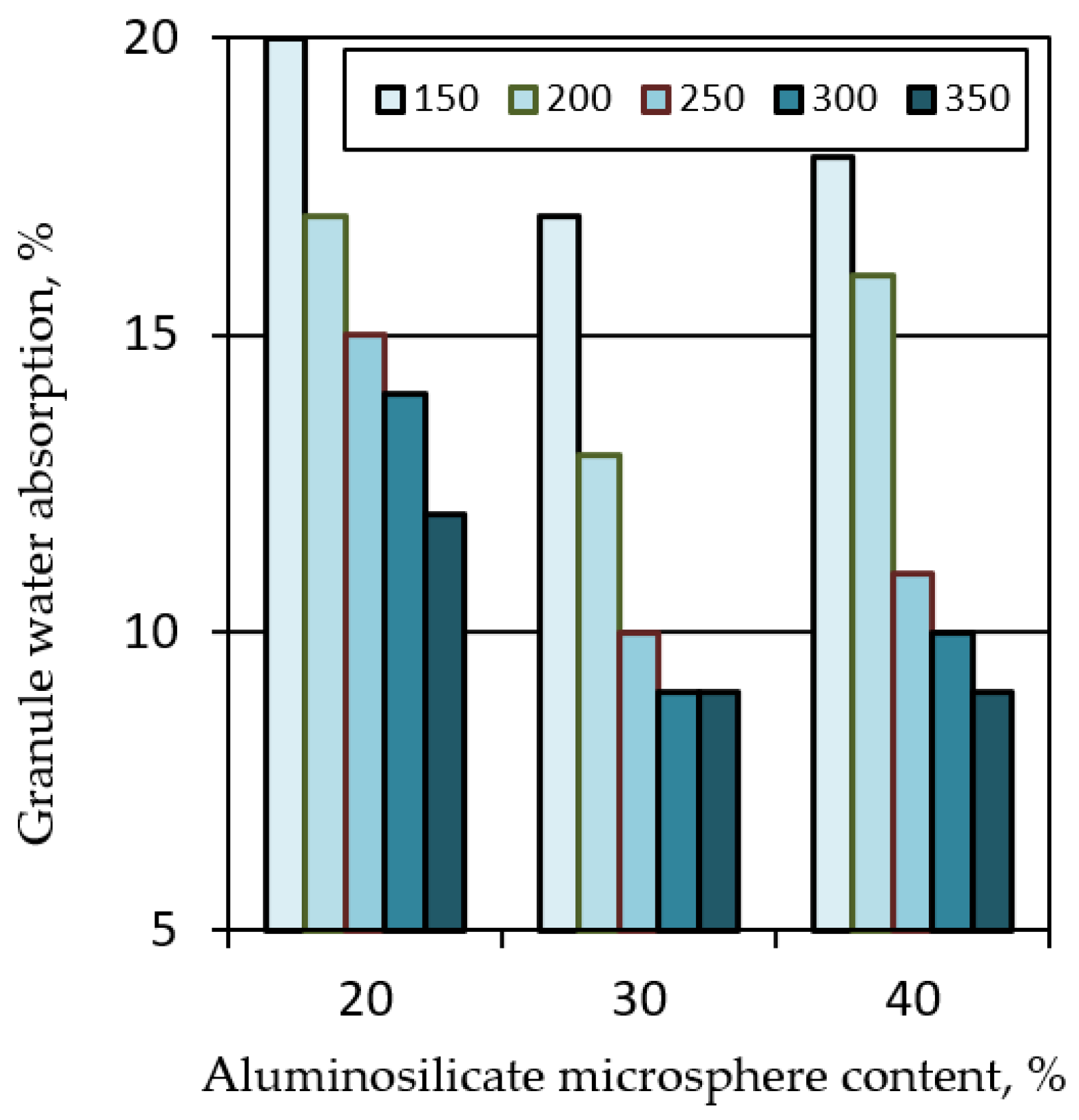


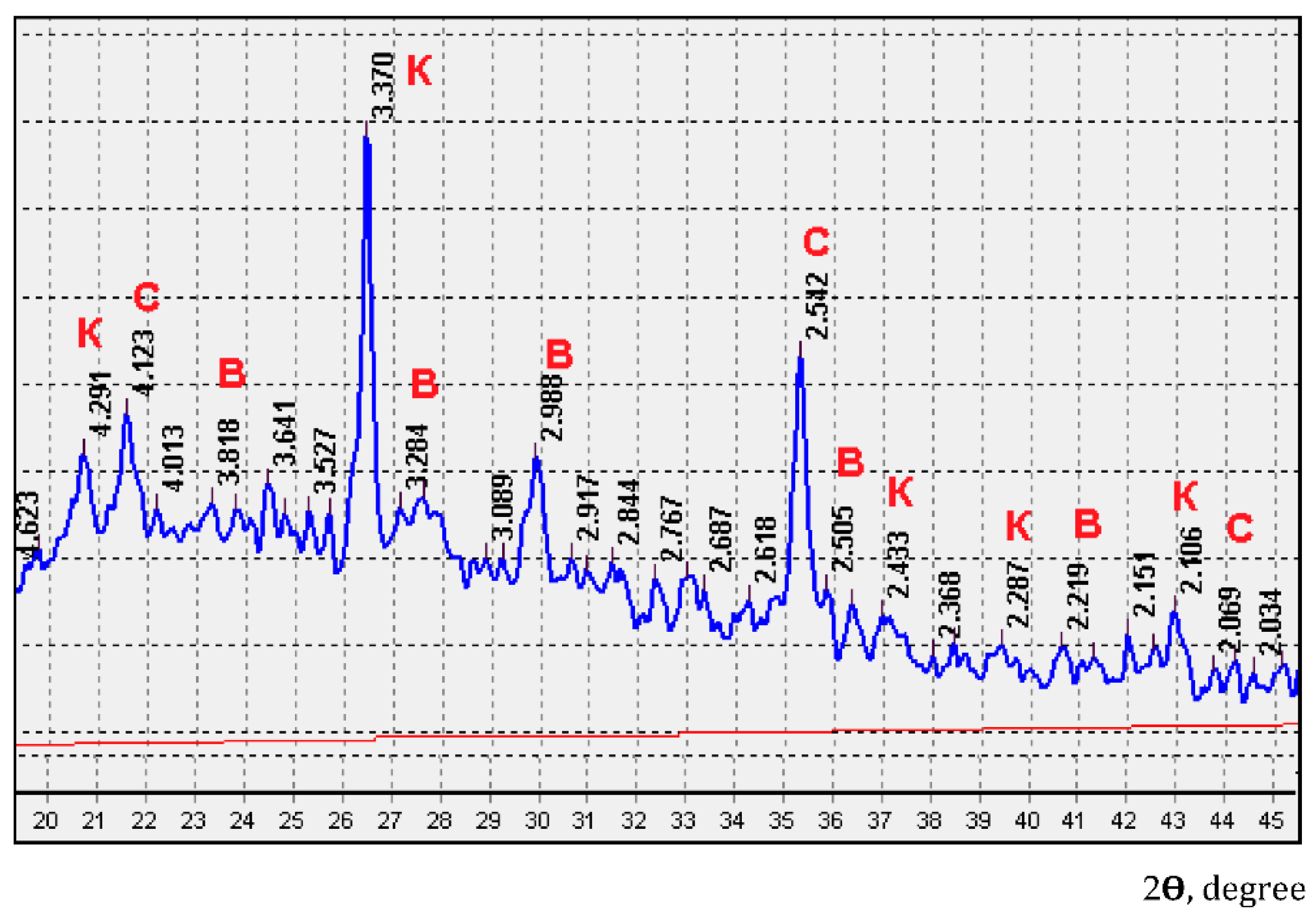
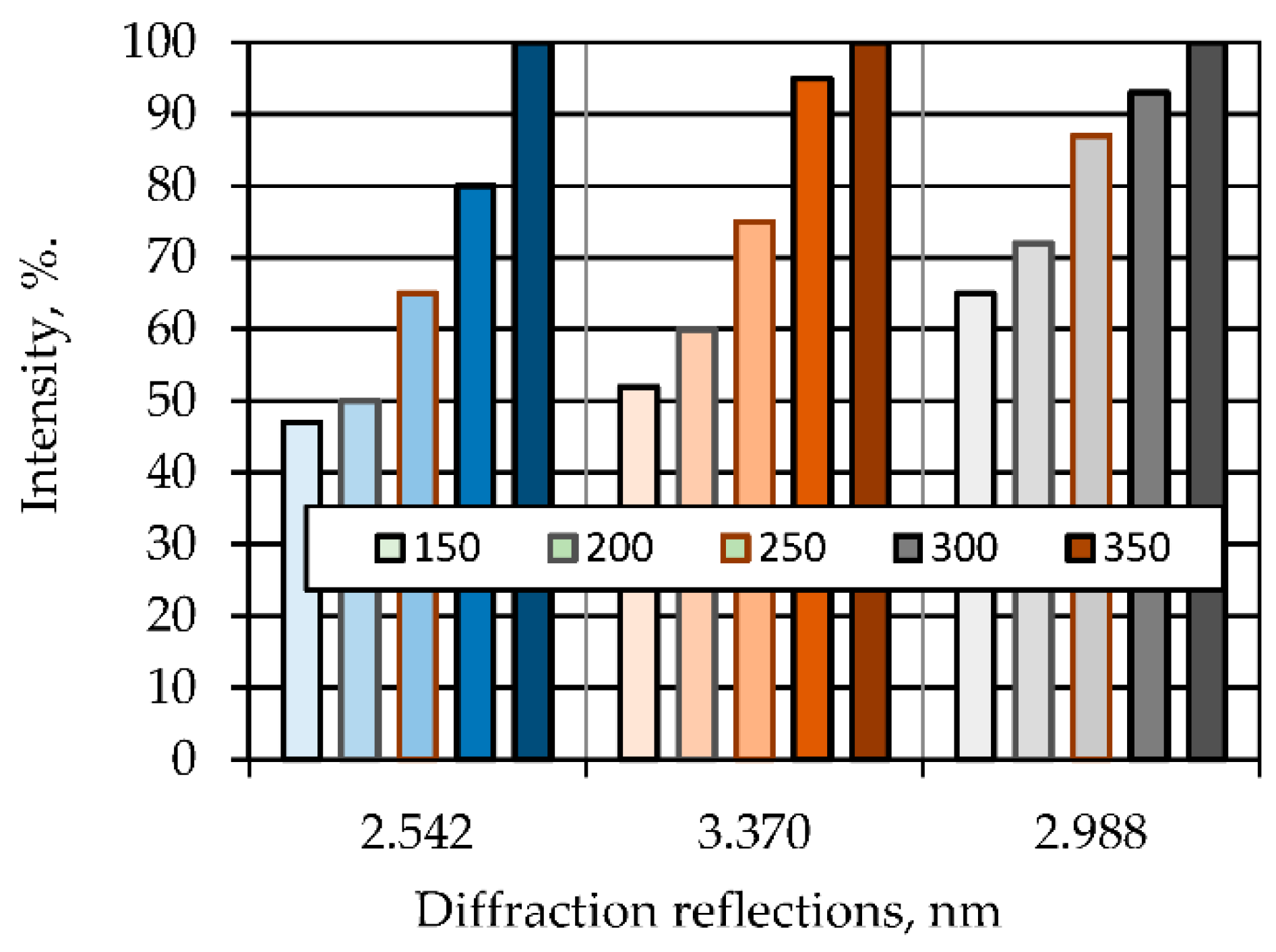


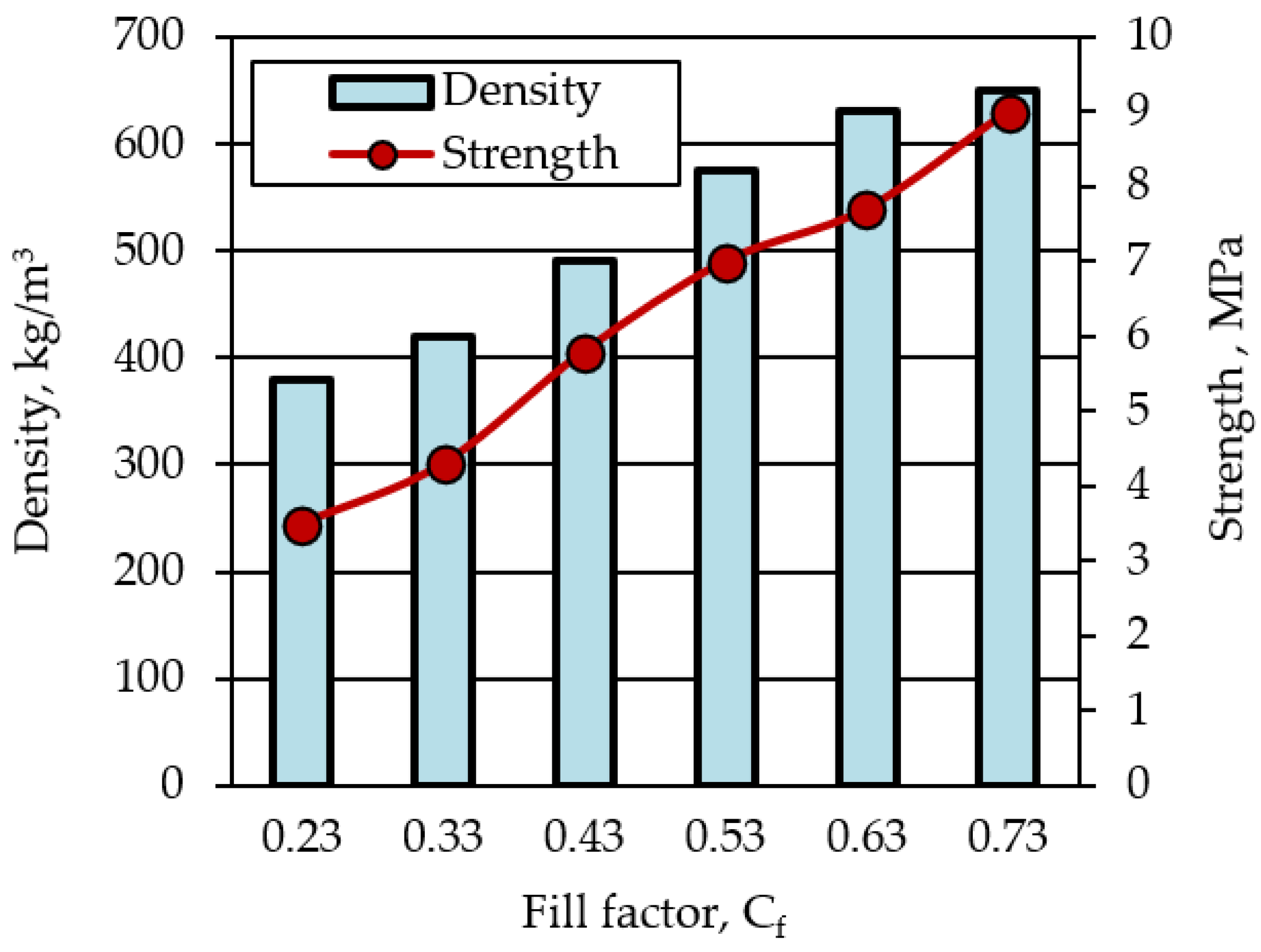

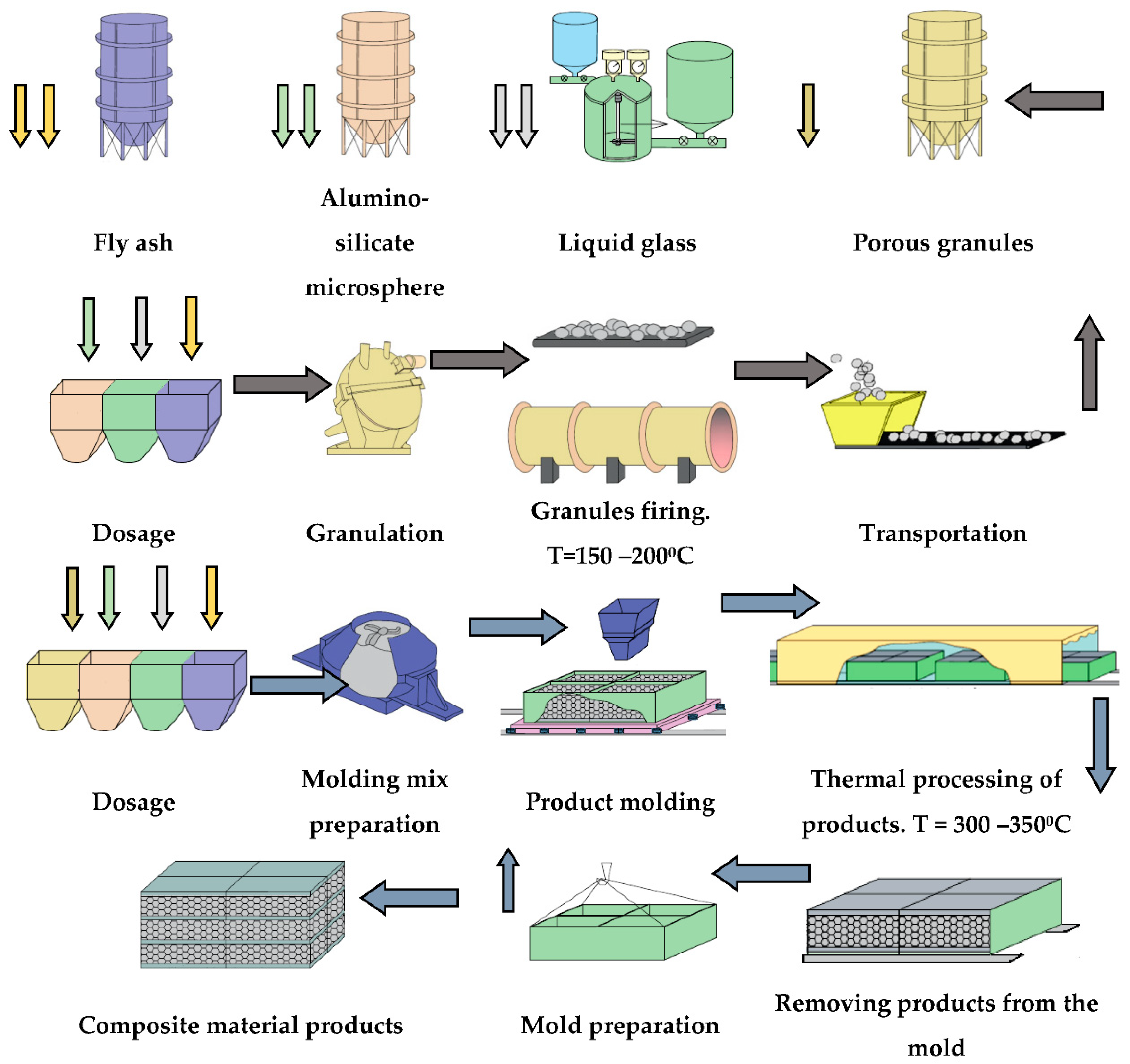
| Content of Oxides, % | Liquid Glass | Fly Ash | Aluminosilicate Microsphere |
|---|---|---|---|
| SiO2 | 28.9 | 48.5 | 68.3 |
| Al2O3 | 0.1 | 17.8 | 25.5 |
| Fe2O3 | 0.1 | 1.4 | 1.5 |
| CaO | 0.2 | 14.8 | 2.2 |
| MgO | – | 3.3 | 1.5 |
| Na2O | 10.7 | 1.3 | 0.3 |
| SO3 | – | 2.6 | 0.7 |
| loss on ignition | 60.0 | 10.0 | – |
| Mix ID | Composition and Characteristics of Liquid Glass Mixtures, % | Liquid Glass: Filler | Characteristics of the Liquid Glass Mixture | |
|---|---|---|---|---|
| Fly Ash | Aluminosilicate Microsphere | |||
| 1 | 100 | 0 | 0.65 | plastic |
| 2 | 80 | 20 | plastic | |
| 3 | 60 | 40 | tough | |
| 4 | 40 | 60 | tough | |
| 5 | 20 | 80 | very tough | |
| 6 | 0 | 100 | no connectivity | |
| 7 | 100 | 0 | 0.75 | very plastic |
| 8 | 80 | 20 | very plastic | |
| 9 | 60 | 40 | plastic | |
| 10 | 40 | 60 | plastic | |
| 11 | 20 | 80 | tough | |
| 12 | 0 | 100 | very tough | |
| 13 | 100 | 0 | 0.85 | viscoplastic |
| 14 | 80 | 20 | viscoplastic | |
| 15 | 60 | 40 | very plastic | |
| 16 | 40 | 60 | plastic | |
| 17 | 20 | 80 | plastic | |
| 18 | 0 | 100 | tough | |
| 19 | 100 | 0 | 0.95 | viscous |
| 20 | 80 | 20 | viscous | |
| 21 | 60 | 40 | viscoplastic | |
| 22 | 40 | 60 | viscoplastic | |
| 23 | 20 | 80 | plastic | |
| 24 | 0 | 100 | plastic | |
| 25 | 100 | 0 | 1.05 | viscous |
| 26 | 80 | 20 | viscous | |
| 27 | 60 | 40 | very viscous | |
| 28 | 40 | 60 | very viscous | |
| 29 | 20 | 80 | viscoplastic | |
| 30 | 0 | 100 | viscoplastic | |
| 31 | 100 | 0 | 1.15 | fluid |
| 32 | 80 | 20 | fluid | |
| 33 | 60 | 40 | fluid | |
| 34 | 40 | 60 | viscous | |
| 35 | 20 | 80 | very viscous | |
| 36 | 0 | 100 | viscoplastic | |
| 37 | 100 | 0 | 1.25 | very fluid |
| 38 | 80 | 20 | very fluid | |
| 39 | 60 | 40 | very fluid | |
| 40 | 40 | 60 | fluid | |
| 41 | 20 | 80 | viscous | |
| 42 | 0 | 100 | very viscous | |
| Characteristics of the Liquid Glass Mixture | Description of the State of the Liquid Glass Mixture |
|---|---|
| No connectivity | The mixture is loose and friable. The lack of liquid glass excludes the formation of solid shells on the surface of the filler particles. |
| Very tough | The mixture is loose. The shells of liquid glass on the surface of the filler particles are very thin, the bond between the particles is weak. |
| Tough | The loose mixture consists of individual aggregates of filler particles held together by shells of liquid glass. |
| Plastic | The mixture is characterized by the continuity of the structure. The filler particles are densely packed and hold the liquid glass shells. |
| Very plastic | The mixture is characterized by the continuity of the structure. Packing of filler particles in liquid glass is loose. |
| Viscoplastic | The mixture is characterized by the continuity of the structure. Filler particles move freely in liquid glass. |
| Very viscous | The mixture sticks to the surface of the bodies. |
| Viscous | The mixture is distributed over the surface of the bodies. |
| Fluid | The mixture flows down the vertical surface of the bodies. |
| Very fluid | The mixture easily flows over the vertical surface of the bodies, forming a thin layer. |
| Mix ID * | The Composition of the Molding Liquid Mixture, wt.% | Plastic Strength of the Molding Mixes, MPa | Properties of Molded Granules | |||
|---|---|---|---|---|---|---|
| Fly Ash | Alumino- Silicate Microsphere | Liquid Glass | Density, kg/m3 | Crush Strength, N/Granule | ||
| 9 | 30 | 20 | 50 | 0.23 | 985 | 15.0 |
| 10 | 20 | 30 | 50 | 0.21 | 980 | 15.7 |
| 11 | 10 | 40 | 50 | 0.25 | 965 | 16.1 |
| 15 | 28 | 19 | 53 | 0.13 | 890 | 11.2 |
| 16 | 19 | 28 | 53 | 0.15 | 870 | 12.0 |
| 17 | 10 | 37 | 53 | 0.17 | 855 | 13.4 |
| Temperature, °C | Bulk Density, kg/m3, of Granule with Diameter, mm | |||
|---|---|---|---|---|
| 7 | 10 | 15 | 20 | |
| 150 | 310 | 270 | 270 | 245 |
| 200 | 380 | 250 | 245 | 220 |
| 250 | 265 | 250 | 235 | 205 |
| 300 | 255 | 245 | 210 | 190 |
| 350 | 240 | 230 | 210 | 175 |
| Appearance and macrostructure of granules | ||||
| 350 | 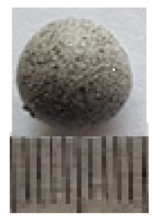 | 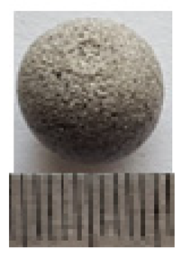 | 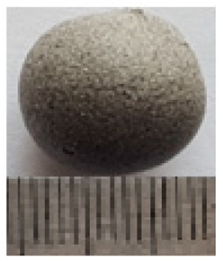 |  |
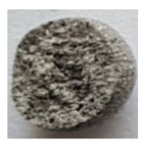 |  |  | 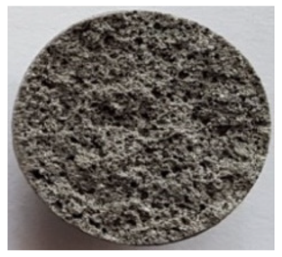 | |
| Temperature, °C | Porosity, % | Strength, MPa | Softening Co Efficient |
|---|---|---|---|
| 150 | 73.2 | 1.9 | 0.25 |
| 200 | 75.2 | 2.5 | 0.70 |
| 250 | 76.0 | 3.3 | 0.75 |
| 300 | 77.5 | 2.9 | 0.81 |
| 350 | 78.1 | 2.4 | 0.92 |
| Mix ID * | The Composition of the Molding Liquid Mixture, wt.% | Slump Flow, mm | Appearance of the Mass | ||
|---|---|---|---|---|---|
| Fly Ash | Aluminosilicate Microsphere | Liquid Glass | |||
| 33 | 23 | 16 | 61 | 150 |  |
| 39 | 22 | 15 | 63 | 175 |  |
| 40 | 15 | 22 | 63 | 163 | 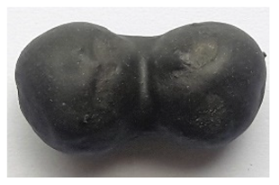 |
| Temperature, °C | Density, kg/m3 | Compressive Strength, MPa | Softening Coefficient | Macrostructure |
|---|---|---|---|---|
| 150 | 830 | 10.6 | 0.23 | 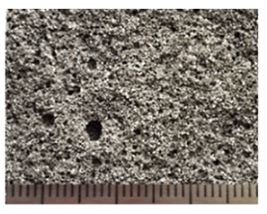 |
| 200 | 710 | 9.5 | 0.67 | 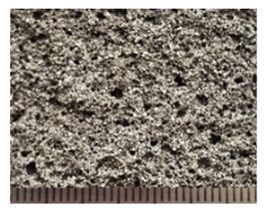 |
| 250 | 590 | 7.2 | 0.82 |  |
| 300 | 585 | 6.8 | 0.85 | 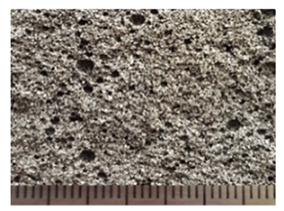 |
| 350 | 570 | 7.0 | 0.87 |  |
| Characteristics | Value | Appearance |
|---|---|---|
| Density, kg/m3 | 500–520 | 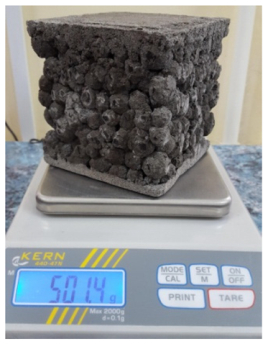 |
| Thermal conductivity, W/(m °C) | 0.095–0.100 | |
| Water absorption (48 h), % | 17–23 | |
| Compressive strength, MPa | 4.7–5.2 | |
| Softening coefficient (7 d) | 0.87–0.90 | |
| Frost resistance, cycles | 50 | |
| Thermal resistance, thermal exchangers | 25 | |
| Heat resistance at a temperature of 1050 °C (“residual” strength after 25 cycles, MPa/initial strength, MPa) | 5.2/4.7 |
Publisher’s Note: MDPI stays neutral with regard to jurisdictional claims in published maps and institutional affiliations. |
© 2022 by the authors. Licensee MDPI, Basel, Switzerland. This article is an open access article distributed under the terms and conditions of the Creative Commons Attribution (CC BY) license (https://creativecommons.org/licenses/by/4.0/).
Share and Cite
Miryuk, O.; Fediuk, R.; Amran, M. Porous Fly Ash/Aluminosilicate Microspheres-Based Composites Containing Lightweight Granules Using Liquid Glass as Binder. Polymers 2022, 14, 3461. https://doi.org/10.3390/polym14173461
Miryuk O, Fediuk R, Amran M. Porous Fly Ash/Aluminosilicate Microspheres-Based Composites Containing Lightweight Granules Using Liquid Glass as Binder. Polymers. 2022; 14(17):3461. https://doi.org/10.3390/polym14173461
Chicago/Turabian StyleMiryuk, Olga, Roman Fediuk, and Mugahed Amran. 2022. "Porous Fly Ash/Aluminosilicate Microspheres-Based Composites Containing Lightweight Granules Using Liquid Glass as Binder" Polymers 14, no. 17: 3461. https://doi.org/10.3390/polym14173461
APA StyleMiryuk, O., Fediuk, R., & Amran, M. (2022). Porous Fly Ash/Aluminosilicate Microspheres-Based Composites Containing Lightweight Granules Using Liquid Glass as Binder. Polymers, 14(17), 3461. https://doi.org/10.3390/polym14173461








